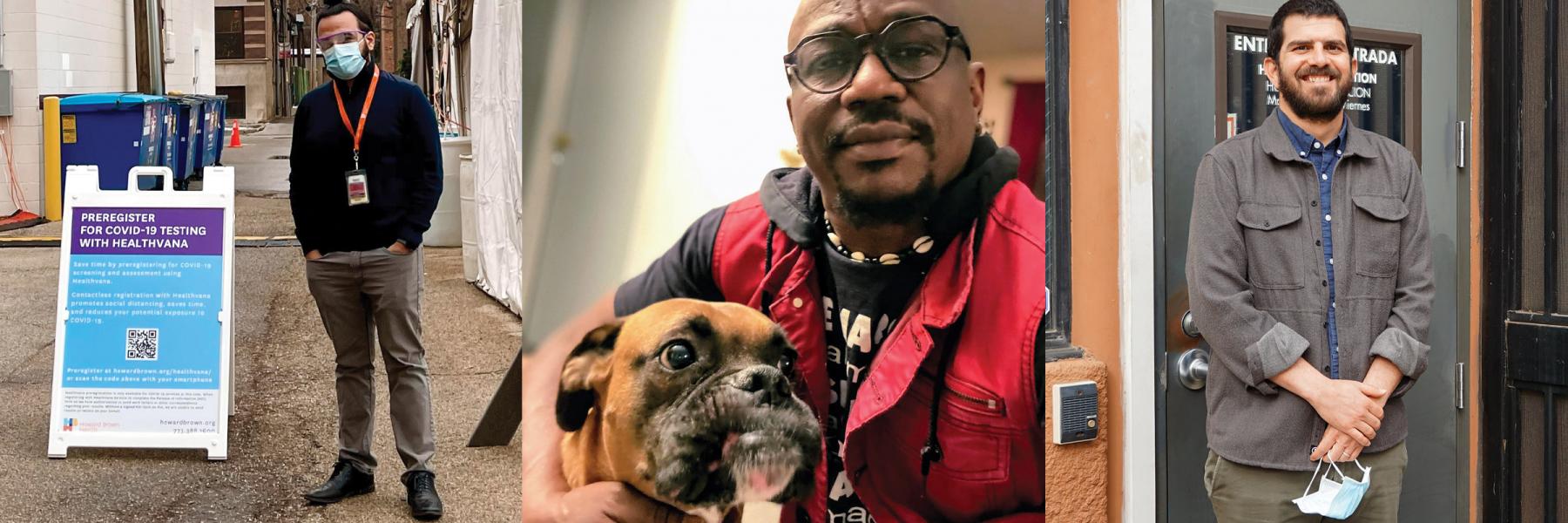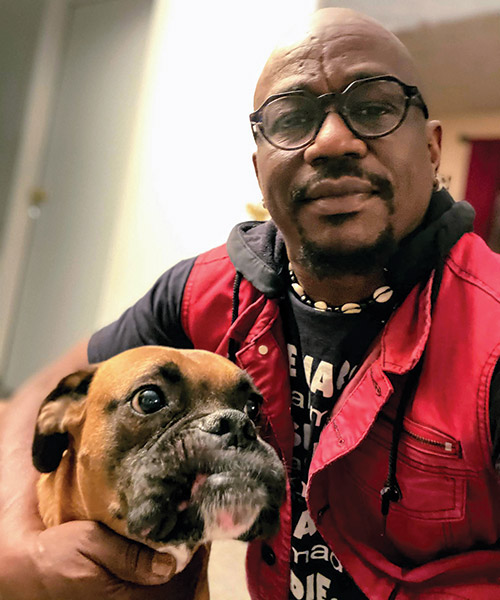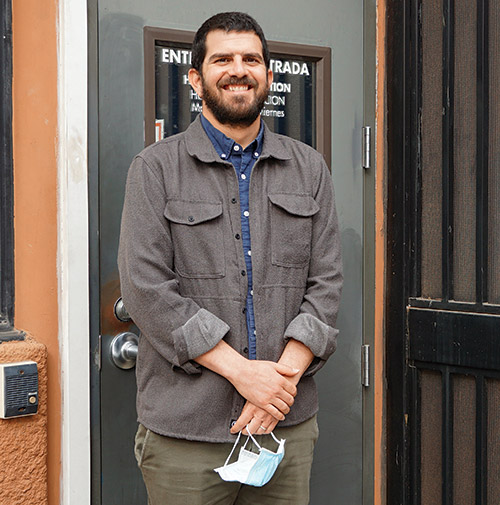“I love my job—I’m an emotional Pisces. I’m a fixer and I’m working all of the time. If I’m available, I will be there for my clients. I’m not even close to burn-out.”
—Tony Christon-Walker, AIDS Alabama
In March, 2020, the hustle and bustle of life in the United States came to an abrupt halt due to the explosion of the COVID-19 pandemic. Workers were sent home with laptops and notepads and pens and files crammed into their work bags. Toilet paper was scarce and disinfecting wipes were scarcer. Dry goods like rice and pasta were gone. And COVID tests were hard to come by, regardless of what then-President Trump kept insisting.
However, very quickly, the frontline workers of the AIDS pandemic—HIV testing counselors—knew that they had to get back to their jobs. This new pandemic didn’t negate the old one. People were still getting HIV or didn’t know that they already had it. Testing programs had to take stock and figure out how to serve their communities without putting their staff at risk. Remarkable stories of commitment and resilience can be told from every corner of the country. And an actual at-home COVID test kit received emergency authorization from the U.S. Food and Drug Administration (FDA) in November 2020.
Christon-Walker with his boyfriend’s dog, Chief
AIDS Alabama - Birmingham, Alabama
Tony Christon-Walker, Director of Prevention and Community Partnerships at AIDS Alabama, is a fighter. Diagnosed with HIV in the mid-1990s “when all of my friends were dying,” he is also a colorectal cancer survivor and has been cancer-free for the last five years. He not only fights for his own health, he also fights for the health of people of color in Birmingham. “We are in the buckle of the Bible Belt. It’s hard to talk about HIV down here.”
Tony’s program “never shut down but we scaled back” and added face masks and temperature testing at the doors. AIDS Alabama’s testing program serves mainly Black and Latino men who have sex with men (MSM). Their client breakdown is approximately 90% Black, 5% Latinx, and 5% white. While clients are able to enter AIDS Alabama facilities, staff also provide in-home HIV testing and drive a nondescript car to clients’ homes. In those cases, his team goes in pairs, “both for the safety of the staff and of the client.” Pre-COVID, “we were testing 30–40 people a week; now we are testing 30 a month.” Although on one November day, they had 11 walk-ins for HIV testing, something that Tony calls “remarkable.” And “people test because they are scared. They put into their mind that if they only sleep with one person, instead of the whole city, they will be safer.” But five people tested positive for HIV in the past five weeks at one of AIDS Alabama’s sites. Their reactions to their HIV diagnosis during COVID are much the same as pre-COVID. “They get that lump in their stomach. Some cry themselves into a puddle. Some blame other people. Some live, and even thrive, with it.”
Tony and a colleague went to the home of a young Black man who has sex with men who wanted an HIV test. He lived with his mother and grandmother, though, so Tony and his colleague had to “sneak in when the coast was clear.” Luckily, the client’s room was right by the front door. “His grandmother was in the back, watching The Price is Right and neither his granny or his mom had any clue that we had even been there. Fortunately, he remains HIV-negative, because if he needed treatment, I don’t know how we would get him out of that apartment.”
During the first week of November 2020, AIDS Alabama started testing for COVID. Staff conducts testing at their sites and in people’s homes, “if we need to in order to eliminate those barriers.” Quite ironically, Tony was interviewed for this article on Tuesday, November 10, and tested positive for COVID on Friday. The night before testing positive, he had watched Avengers: End Game with his family—his husband, son, and grandchildren—and some family members went dancing later. Tony was shocked “and mad! I’ve been being very careful!” At work, he had been using PPE and staying six feet apart from coworkers and clients since March. Thinking it was a false positive result, a colleague went to his home to retest him. Frustratingly, “that bright red indicator showed up again.” No one else in Tony’s family tested positive for COVID and he quarantined himself from his husband and son. “I feel kind of guilty,” he says. “How did this happen to me? Everyone else is dying and I feel just fine. It doesn’t seem fair.” He feels the same sense of guilt when he goes to his follow-up appointments at the oncologist’s office and sees the very sick people in the waiting room. Tony specifically wanted to include his COVID diagnosis in this article, “because if it can happen to me, it can happen to anyone.” And while he has no symptoms, “just because I’m okay, it doesn’t mean that you’re okay or will be okay.” Tony quarantined himself, worked from home, did not develop the classic COVID symptoms, and returned to his office on December 1st. “But the [political] left only talks about the deaths, the right only talks about how many people have it but don’t have symptoms, there is no discussion in the middle. I almost feel like COVID is a sentient being that decides what it is going to do with somebody. I didn’t have those symptoms but I felt it when I got it and felt it when it left me.” As of the writing of this article, another AIDS Alabama employee tested positive for COVID and has lost their sense of taste and smell.
Elizondo outside the tent where testing is conducted (photo by Carlos Fragoso)
Howard Brown Health - Chicago, Illinois
Antonio Elizondo is the Manager of Reproductive Health Outreach Services at Howard Brown Health. A network of clinics across Chicago, Howard Brown provides medical services to the LGBTQ community, including HIV, sexually transmitted infection (STI), and COVID testing. Approximately 40% of their clients are white and 60% are people of color. About 55% are male and 45% female (this includes people who are transgender). Since March, Howard Brown’s testing programs have “temporarily gone backwards”—meaning that there are a limited number of clinics that are open, and those that are “have moved primarily to telehealth.” Their smaller clinics “have lower capacity to see clients but those clients are still sexually active—even during COVID.” Across the Howard Brown clinic system, HIV testing numbers fell by 1,000–2,000 each month from March through October. Although the number of in-person clients decreased, their seropositivity rates had spikes. In May and September, their HIV positivity rates for 2020 were higher than in 2019. In May 2019, the positivity rate was 0.36% compared to the following May’s 0.81%. And in September 2019, the positivity rate was 0.26% vs. 0.99% in September 2020.
But Howard Brown is not letting COVID win the battle against HIV. In April 2020, the agency started offering free at-home HIV testing via their website, mailing out OraQuick In Home HIV test kits to 20 states across the U.S. (as well as to Puerto Rico and Ontario, Canada). This particular kit tests for HIV antibodies present in the mucous membrane of the mouth and involves an oral swab. Along with the standard list of HIV/AIDS resources included in the test kit, Howard Brown included information about their own HIV testing and counseling program and how to contact their counselors. They also sent out free safer sex packets (again, via online order) which include condoms (receptive, insertive, and/or latex-free), lube, dental dams, cloth face masks, and safer injection kits (works but no needles). From April through September, “we filled orders for 377 OraQuick In Home HIV test kits, 6,350 condoms, 2,900 lube packets, 226 cloth masks, and 112 safer injection kits”—an impressive set of numbers. At the time of this article, Howard Brown had not received any contact regarding positive at-home HIV test results. But that doesn’t necessarily mean that no one has had a reactive result. A client could have contacted a local resource or one of the national resources included in the kit (or, they might not have reached out to anyone at all, which is concerning).
In September, Howard Brown changed their HIV and STI testing protocol yet again, working with a third-party vendor, MyLabBox. The company ships, receives, and processes HIV and STI tests and informs Howard Brown of any positive results. Prevention staff are then able to be proactive, reaching out to patients directly and linking them to care and treatment. Test kits remain free and can be ordered online (STI tests are now only shipped within the state of Illinois so that a licensed medical provider can prescribe treatment).
According to Michelle Evers, NP, Assistant Site Medical Director, “I think that COVID-19 has had a direct impact on people’s access to care. Many patients are apprehensive of coming onsite to engage in services. Also, some people are not aware of, or have issues with, our telemedicine service line. A large majority of our newly diagnosed patients are young MSM of color. Many of them have had interruptions in their PrEP refills or appointments. They have lost insurance and do not have the resources to understand how to navigate our public health systems. This creates a need for us to try to reach people of color during this time.”
That being said, “Howard Brown currently links 87% of patients to care within three months of their HIV diagnoses, as per the guidelines set by the National HIV/AIDS Strategy,” says Antonio.
Howard Brown has been testing for COVID since the safer-at-home orders began in March. The agency “usually tests quickly and in person, out in the community under tents, which reduces travel and indoor contact.” To reach the communities hit hardest by COVID, Howard Brown partners with local community-based organizations, such as Project Vida, which serves the Latinx community. “There is a high utilization of COVID testing at the Latinx site and a high COVID positivity rate,” said Antonio. “And there are higher infection rates per household. Culturally, Latinx families are used to seeing each other and being together. It is hard for them to adjust and accept the new normal.” In the coming freezing winter months in Chicago, tent testing will be unpopular at the very least, and probably not even possible. Howard Brown Health is already considering their next pandemic pivot: drive-through testing.
Sadly, Antonio’s own family will have to accept the “new normal” for the Latinx community. His maternal grandmother passed away from COVID-related complications over the Thanksgiving holiday weekend. His grandfather doesn’t have COVID, so they have to keep him, and other vulnerable family members, safe. At the time of this article, only 10 people were allowed to gather for a funeral or memorial in Illinois. Antonio is concerned that, even with restrictions, the “natural reaction is to hug or touch somebody,” which could lead to COVID transmission. A Zoom memorial is being planned for this normally close-knit family.
Heller at the entrance to common ground (photo by Pamela Kerr)
Common Ground - Venice, California
Jacob Heller, the Prevention Supervisor at Common Ground, has worked at the agency for six years. In addition to HIV-related social services, Common Ground offers testing for HIV, hepatitis C (HCV), and STIs, along with a robust syringe services program (SSP). The Venice Family Clinic (VFC) is right next door, and treats HIV, HCV, and STIs, thus providing other medical care to the beach community. In March 2020, Common Ground saw “a huge decrease in testing numbers—half the rate compared to what we normally do. We work with a risky population. They test out of a situation—something specific happened that scared them,” says Heller.
Common Ground has had to adjust their testing protocols since March. Previously, they would test and counsel in a “small, intimate space.” But “the rules in Los Angeles have changed so much. Now we test in a larger space with more room and oxygen.” Sadly, the testing team “can’t spend as much time with clients as they used to. This is a bummer because staff want to take the time to get to know them and so that the clients tell us the truth [about risk factors].” Currently, everyone who wants an HIV test must have their temperature checked and answer symptom questions at the door of the friendly ASO. Heller’s program discussed passing out home HIV test kits but decided against it because a large percentage of their clients are homeless and therefore might have barriers to accessing the post-test resources included with the kits.
COVID has also forced changes to their syringe services program. Previously, this service would take place in an exam room, and staff “could take their time with each client and build a layer of trust with them.” Now the SSP is out in the open and goes much faster, making those important provider-client relationships harder to build. Common Ground staff wear both masks and face shields, “and the people who inject drugs (PWID) population [are] put off by those barriers,” a blow to a program that “has grown every year for the past four years.” And overdoses in Los Angeles increased in 2020, which could be due to COVID-related stress or the presence of fentanyl in the drugs that people consume.
In contrast to other testing and SSPs across Los Angeles, Common Ground’s clients tend to be White, straight, homeless men. They test more people during the summertime, which makes sense as the agency is located a mere six blocks from the famous Venice Boardwalk. Their seropositivity rate is generally 1–3 per month. When someone is diagnosed with HIV, “we just walk them next door to VHC” for HIV treatment and ancillary services and “teach them to be a champion of their own health.”
Similar to what’s being seen at AIDS Alabama and elsewhere, client responses to testing positive for HIV during COVID are much the same as before COVID, “there are a range of reactions from resigned to freaked out. Most people who test positive have a lack of education and need the counseling and education that comes with HIV testing. Generally, youth are not aware that there are meds to treat and control HIV.” And their HIV status may not be a priority in clients’ hierarchy of needs. Food and shelter may come first. The Medical Care Coordination Team (MCC) at VHC started delivering medications and food to clients who were nervous about leaving their home during COVID. One newly housed client did not have anything to put into her new residence. Common Ground staff came together and donated couches and other items that she needed in order “to make her home a home.”
“We go the extra mile,” says Heller. “We care about our clients. They have experienced so much trauma and anxiety and fear. We are not here by force, we are here by choice.”
Michelle Simek has worked in HIV/AIDS for more than 20 years. She currently works at the UCLA Center for Clinical AIDS Research and Education (C.A.R.E.) and is a popular HIV/AIDS educational presenter, both locally and nationally. In her spare time, she is an actor, avid reader, enthusiastic concert-goer, and proud mom of Baxter, her rescue cat.
COVID testing at home
Last November 17, the FDA issued an emergency use authorization (EUA) for the very first rapid, at-home COVID test, called Lucira. Previously, anyone who was worried could purchase a COVID test-kit online (at various price points), test at home, and send the kit to a lab for processing (which meant quite a bit of waiting time for the results). The new test is a nasal swab and is only available via prescription from a medical doctor. The Lucira test can be self-administered at home by anyone who is at least 14 years old; the test can also be used in medical settings (such as hospitals, urgent care facilities, and emergency rooms). After collecting the swab, it is swirled in a vial that is placed inside the test unit. In approximately 30 minutes, the results are visible in the lit display. If a positive result appears, it is recommended that the patient immediately contact their medical provider and self-quarantine. FDA Commissioner Stephen M. Hahn, MD, stated that, “While COVID-19 diagnostic tests have been authorized for at-home collection, this is the first that can be fully self-administered and provide results at home.” At the time of this article, various questions remained unanswered about how the test will be distributed, its cost, and whether health insurance will cover it.





